Unambiguous ISAR Imaging Method for Complex Maneuvering Group Targets
Abstract
:1. Introduction
- It results in the difficulty of correcting migration through resolution cell (MTRC) [1] for accurate target rotation parameters estimation. Without the Doppler ambiguity, MTRC can be compensated for by methods such as Keystone [1], and only the Doppler diffusion caused by the higher-order phase is considered. In general, the echo of maneuvering targets can be seen as multi-component linear frequency modulation (LFM) signals in the slow-time domain [2]. ISAR imaging methods for LFM signals can be categorized into two types: time–frequency analysis methods, such as Wigner–Ville distribution [2,3,4], Radon–Wigner transform [5,6], and LV’s distribution (LVD) [7,8], and parameter estimation methods, such as matched Fourier transform (MFT) [9,10] and Chirp–Fourier transform [11,12]. With improvement in the maneuverability of the air targets, the echo can be further modeled as m-CPS [13,14]. Most ISAR imaging methods for m-CPS are based on parameter estimation, including cubic phase function (CPF) [15,16,17,18], high-order ambiguity function (HAF) [19,20,21,22,23], and discrete polynomial phase transformation (DPT) [24]. In recent years, some scholars proposed novel methods based on other well-performing time–frequency distributions [25,26,27]. With the Doppler ambiguity, however, MTRCs can no longer be effectively compensated for by the aforementioned methods. This will further cause difficulty in estimating the echo parameters to compensate rotational motion of targets. Therefore, it is of critical value to design an effective parameter estimation algorithm without corrected MTRC.
- Scattering centers with Doppler ambiguity will appear in an incorrect position [28,29], which highlights the necessity of removing the Doppler ambiguity. To our best knowledge, however, few studies focus on dealing with this issue. Dr. Huang and Dr. Zhang [30] presented a hypothesis that Doppler ambiguity removal can be carried out by sparse reconstruction. However, their proposed method has limited effectiveness for the m-CPS model.
2. Materials and Methods
2.1. Signal Model
2.2. Parameters Estimation Based on HIAF–GSCFT
2.3. Doppler Ambiguity Removal Based on MWC
2.4. ISAR Imaging Method Based on HIAF–GSCFT and Doppler Ambiguity Removal
- Step 1
- Obtain by processing the original echo signal using stretch processing;
- Step 2
- Estimate and using HIAF–GSCFT;
- Step 3
- Estimate and with PS, GSCFT, inverse Fourier transform, and the compensation function constructed by the estimated echo parameters;
- Step 4
- Remove the Doppler ambiguity by using the MWC and determine the actual Doppler frequency of the dominant scattering center;
- Step 5
- Estimate the amplitude of the dominant scattering center by the least-squares method as
- Step 6
- Delete the echo of the dominant scattering center from as
- Step 7
- Repeat steps (2)–(6) till the residual energy of the echo reach the energy threshold;
- Step 8
- Reconstruct the echo by
3. Results
3.1. Validation of the Parameters Estimation Method Based on HIAF–GSCFT
3.2. Validation of the Capability of Single Target Imaging
3.3. Validation of Imaging for Complex Maneuvering Group Targets
4. Conclusions
Author Contributions
Funding
Data Availability Statement
Acknowledgments
Conflicts of Interest
Appendix A
References
- Xing, M.; Wu, R.; Lan, J.; Bao, Z. Migration Through Resolution Cell Compensation in ISAR Imaging. IEEE Geosci. Remote Sens. Lett. 2004, 1, 141–144. [Google Scholar] [CrossRef]
- Berizzi, F.; Mese, E.; Diani, M.; Martorella, M. High-resolution ISAR imaging of maneuvering targets by means of the range instantaneous Doppler technique: Modeling and performance analysis. IEEE Trans. Image Process. 2001, 10, 1880–1890. [Google Scholar] [CrossRef] [PubMed]
- Barbarossa, S. Analysis of multicomponent LFM signals by a combined Wigner-Hough transform. IEEE Trans. Signal Process. 1995, 43, 1511–1515. [Google Scholar] [CrossRef]
- Wang, Y.; Jiang, Y. ISAR Imaging of Maneuvering Target Based on the L-Class of Fourth-Order Complex-Lag PWVD. IEEE Trans. Geosci. Remote Sens. 2010, 48, 1518–1527. [Google Scholar] [CrossRef]
- Wood, J.; Barry, D. Radon transformation of time-frequency distributions for analysis of multicomponent signals. IEEE Trans. Signal Process. 1994, 42, 3166–3177. [Google Scholar] [CrossRef]
- Li, W.-C.; Wang, X.-S.; Wang, G.-Y. Scaled Radon-Wigner Transform Imaging and Scaling of Maneuvering Target. IEEE Trans. Aerosp. Electron. Syst. 2010, 46, 2043–2051. [Google Scholar] [CrossRef]
- Yang, T.L.; Yang, L.; BI, G. ISAR cross-range scaling algorithm based on LVD. In Proceedings of the 2016 39th International Conference on Telecommunications and Signal Processing (TSP), Vienna, Austria, 27–29 June 2016; pp. 643–664. [Google Scholar]
- Li, X.L.; Cui, G.L.; Kong, L.J. Fast Non-Searching Method for Maneuvering Target Detection and Motion Parameters Esti-mation. IEEE Trans. Signal Process. 2016, 64, 2232–2244. [Google Scholar] [CrossRef]
- Guo, B.; Sun, H.; Yin, W.; Zeng, H.; Chen, G.; Deng, L. ISAR Imaging Algorithm of Maneuvering Target Based on Matching Flourier Transform. In Proceedings of the 2018 IEEE 4th International Conference on Computer and Communications (ICCC), Chengdu, China, 7–10 December 2018; pp. 1710–1714. [Google Scholar] [CrossRef]
- Wang, Y.; Zhang, Q.; Zhao, B. ISAR imaging of target with complex motion based on novel approach for the parameters estimation of multi-component cubic phase signal. Multidimens. Syst. Signal Process. 2018, 29, 1285–1307. [Google Scholar] [CrossRef]
- Wang, B.; Xu, S.; Wu, W.; Hu, P.; Chen, Z. Adaptive ISAR Imaging of Maneuvering Targets Based on a Modified Fourier Transform. Sensors 2018, 18, 1370. [Google Scholar] [CrossRef] [Green Version]
- Zuo, L.; Wang, B. ISAR Imaging of Non-Uniform Rotating Targets Based on Optimized Matching Fourier Transform. IEEE Access 2020, 8, 64324–64330. [Google Scholar] [CrossRef]
- O’Shea, P.J. A Fast Algorithm for Estimating the Parameters of a Quadratic FM Signal. IEEE Trans. Signal Process. 2004, 52, 385–393. [Google Scholar] [CrossRef] [Green Version]
- O’Shea, P. Improving Polynomial Phase Parameter Estimation by Using Nonuniformly Spaced Signal Sample Methods. IEEE Trans. Signal Process. 2012, 60, 3405–3414. [Google Scholar] [CrossRef]
- Lv, Q.; Su, T.; He, X. An ISAR Imaging Algorithm for Nonuniformly Rotating Targets with Low SNR Based on Modified Bilinear Parameter Estimation of Cubic Phase Signal. IEEE Trans. Aerosp. Electron. Syst. 2018, 54, 3108–3124. [Google Scholar] [CrossRef]
- Zheng, J.; Liu, H.; Liu, Z.; Liu, Q.H. ISAR Imaging of Ship Targets Based on an Integrated Cubic Phase Bilinear Autocorrelation Function. Sensors 2017, 17, 498. [Google Scholar] [CrossRef] [Green Version]
- Zhu, L. Quadratic Frequency Modulation Signals Parameter Estimation Based on Product High Order Ambiguity Func-tion-Modified Integrated Cubic Phase Function. Information 2019, 10, 140. [Google Scholar] [CrossRef] [Green Version]
- Li, L.; Yan, L.; Li, D.; Liu, H.; Zhang, C. A Novel ISAR Imaging Method for Maneuvering Target Based on AM-QFM Model Under Low SNR Environment. IEEE Access 2019, 7, 140499–140512. [Google Scholar] [CrossRef]
- Wang, Y.; Kang, J.; Jiang, Y. ISAR Imaging of Maneuvering Target Based on the Local Polynomial Wigner Distribution and Integrated High-Order Ambiguity Function for Cubic Phase Signal Model. IEEE J. Sel. Top. Appl. Earth Obs. Remote Sens. 2014, 7, 2971–2991. [Google Scholar] [CrossRef]
- Huang, P.; Liao, G.; Yang, Z.; Xia, X.-G.; Ma, J.; Zheng, J. Ground Maneuvering Target Imaging and High-Order Motion Parameter Estimation Based on Second-Order Keystone and Generalized Hough-HAF Transform. IEEE Trans. Geosci. Remote Sens. 2016, 55, 320–335. [Google Scholar] [CrossRef]
- Wang, Y. Inverse synthetic aperture radar imaging of manoeuvring target based on range-instantaneous-Doppler and range-instantaneous-chirp-rate algorithms. IET Radar Sonar Navig. 2013, 6, 921–928. [Google Scholar] [CrossRef]
- Jing, F.L.; Si, W.J.; Wang, Y. Parameter estimation of polynomial-phase signal using the hybrid LvHAF. In Proceedings of the 2017 Progress in Electromagnetics Research Symposium—Fall (PIERS—FALL), Singapore, 19–22 November 2017; pp. 417–426. [Google Scholar]
- Zhang, J.; Su, T.; Zheng, J.; He, X. Parameter estimation of CFM signals based on MICPF-HAF. Electron. Lett. 2018, 54, 456–458. [Google Scholar] [CrossRef]
- Wang, Y.; Huang, X.; Cao, R. Novel Approach for ISAR Cross-Range Scaling Based on the Multidelay Discrete Polynomial- Phase Transform Combined with Keystone Transform. IEEE Trans. Geosci. Remote Sens. 2019, 58, 1221–1231. [Google Scholar] [CrossRef]
- Jin, K.; Lai, T.; Wang, Y.; Xing, X.; Zhao, Y. Parameter estimation of quadratic frequency modulated signal based on three-dimensional scaled Fourier transform. IET Radar, Sonar Navig. 2019, 13, 1689–1696. [Google Scholar] [CrossRef]
- Qian, J.; Huang, S.; Wang, L.; Bi, G.; Yang, X. Super-Resolution ISAR Imaging for Maneuvering Target Based on Deep-Learning-Assisted Time–Frequency Analysis. IEEE Trans. Geosci. Remote Sens. 2021, 60, 1–14. [Google Scholar] [CrossRef]
- Huang, P.; Xia, X.-G.; Zhan, M.; Liu, X.; Liao, G.; Jiang, X. ISAR Imaging of a Maneuvering Target Based on Parameter Estimation of Multicomponent Cubic Phase Signals. IEEE Trans. Geosci. Remote Sens. 2021, 60, 1–18. [Google Scholar] [CrossRef]
- Pan, X.; Wang, W.; Feng, D.; Liu, Y.; Fu, Q.; Wang, G. On deception jamming for countering bistatic ISAR based on sub-Nyquist sampling. IET Radar Sonar Navig. 2014, 8, 173–179. [Google Scholar] [CrossRef]
- Pan, X.; Liu, J.; Chen, J.; Xie, Q.; Ai, X. Sub-Nyquist Sampling Jamming Against Chirp-ISAR with CS-D Range Compression. IEEE Sensors J. 2017, 18, 1140–1149. [Google Scholar] [CrossRef]
- Huang, D.; Zhang, L.; Xing, M.; Bao, Z. Doppler ambiguity removal and ISAR imaging of group targets with sparse decomposition. IET Radar Sonar Navig. 2016, 10, 1711–1719. [Google Scholar] [CrossRef]
- Caputi, W.J. Stretch: A Time-Transformation Technique. IEEE Trans. Aerosp. Electron. Syst. 1971, AES-7, 269–278. [Google Scholar] [CrossRef]
- Bao, Z.; Xing, M.D.; Wang, T. Radar Imaging Technology; Publishing House of Electronics Industry: Beijing, China, 2005; pp. 264–266. [Google Scholar]
- Zheng, J.; Su, T.; Zhu, W.; Zhang, L.; Liu, Z.; Liu, Q.H. ISAR Imaging of Nonuniformly Rotating Target Based on a Fast Parameter Estimation Algorithm of Cubic Phase Signal. IEEE Trans. Geosci. Remote Sens. 2015, 53, 4727–4740. [Google Scholar] [CrossRef]
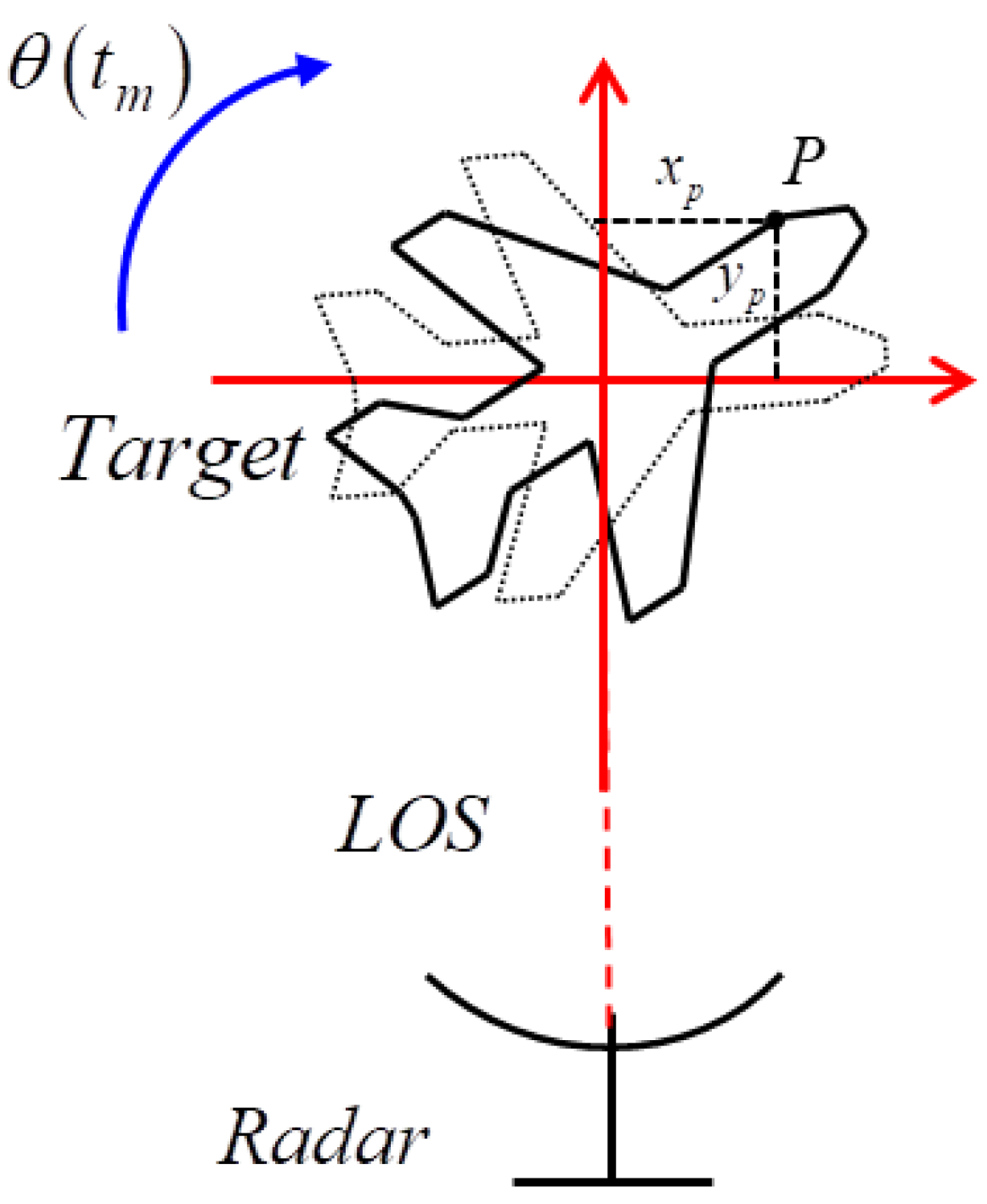

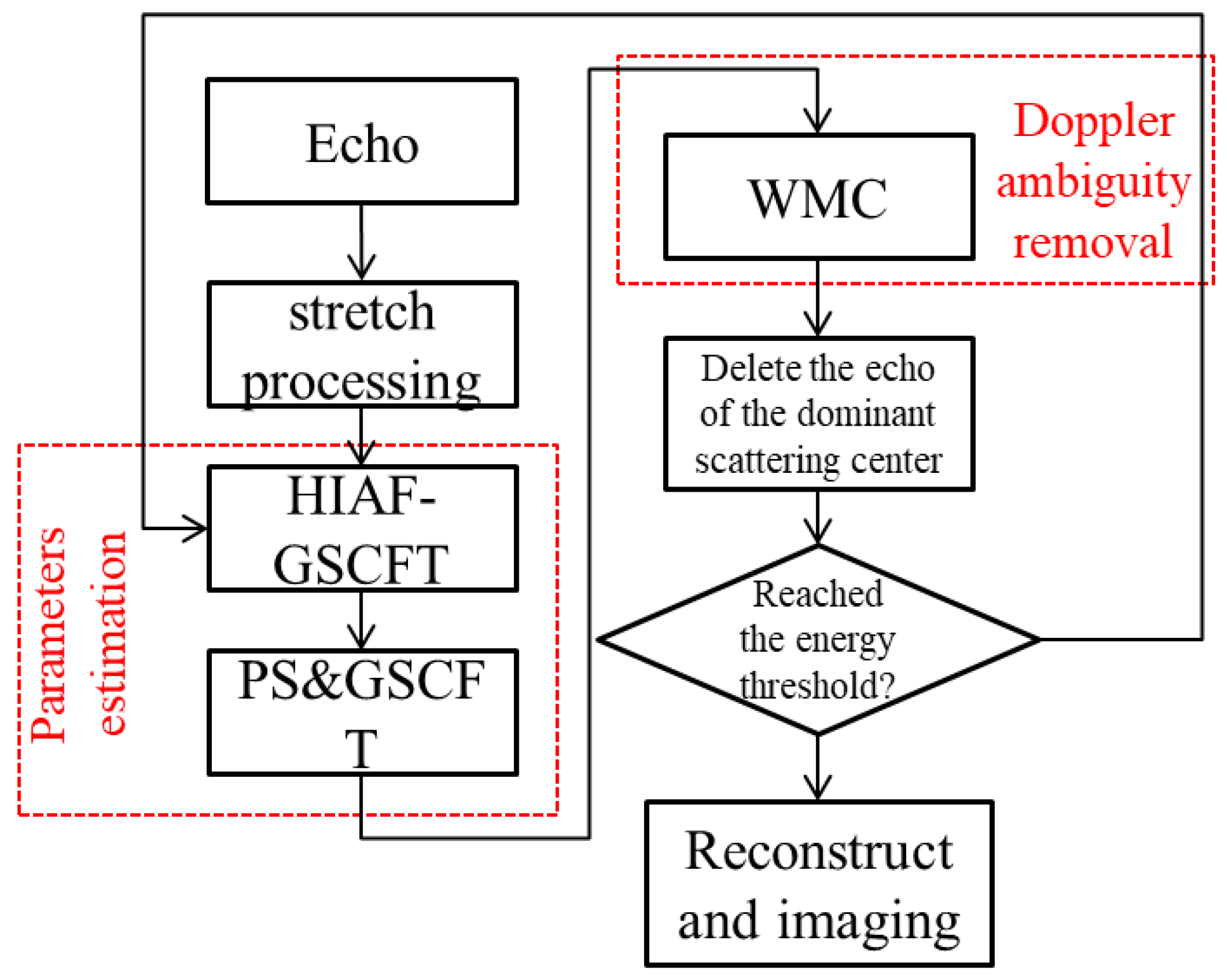
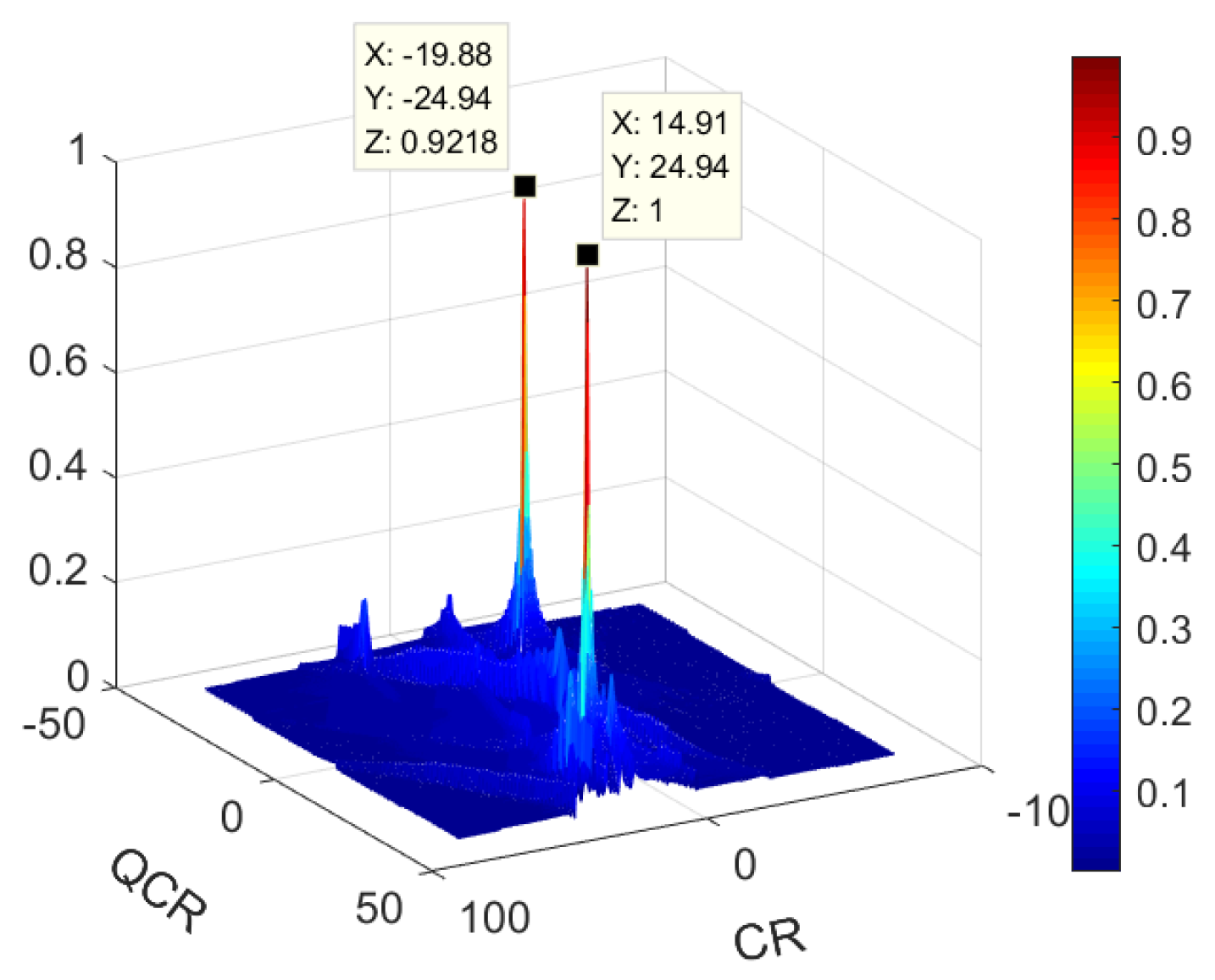
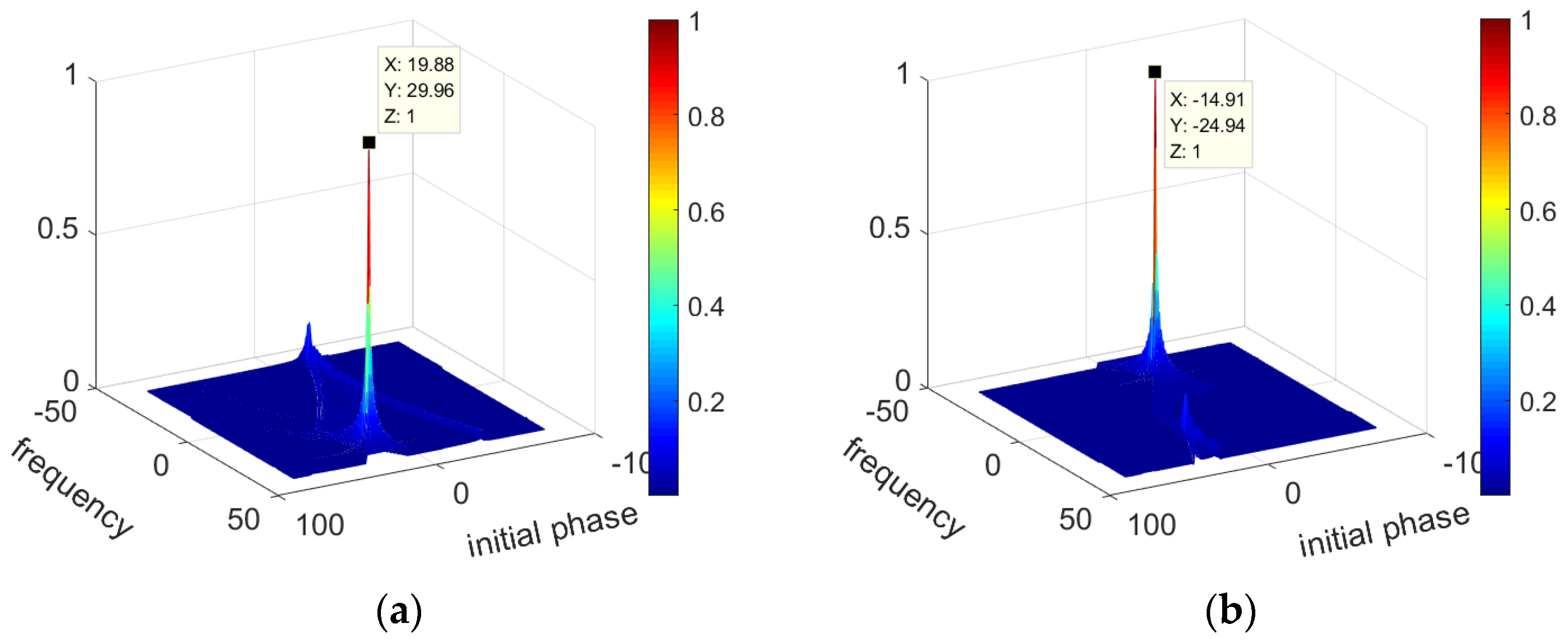






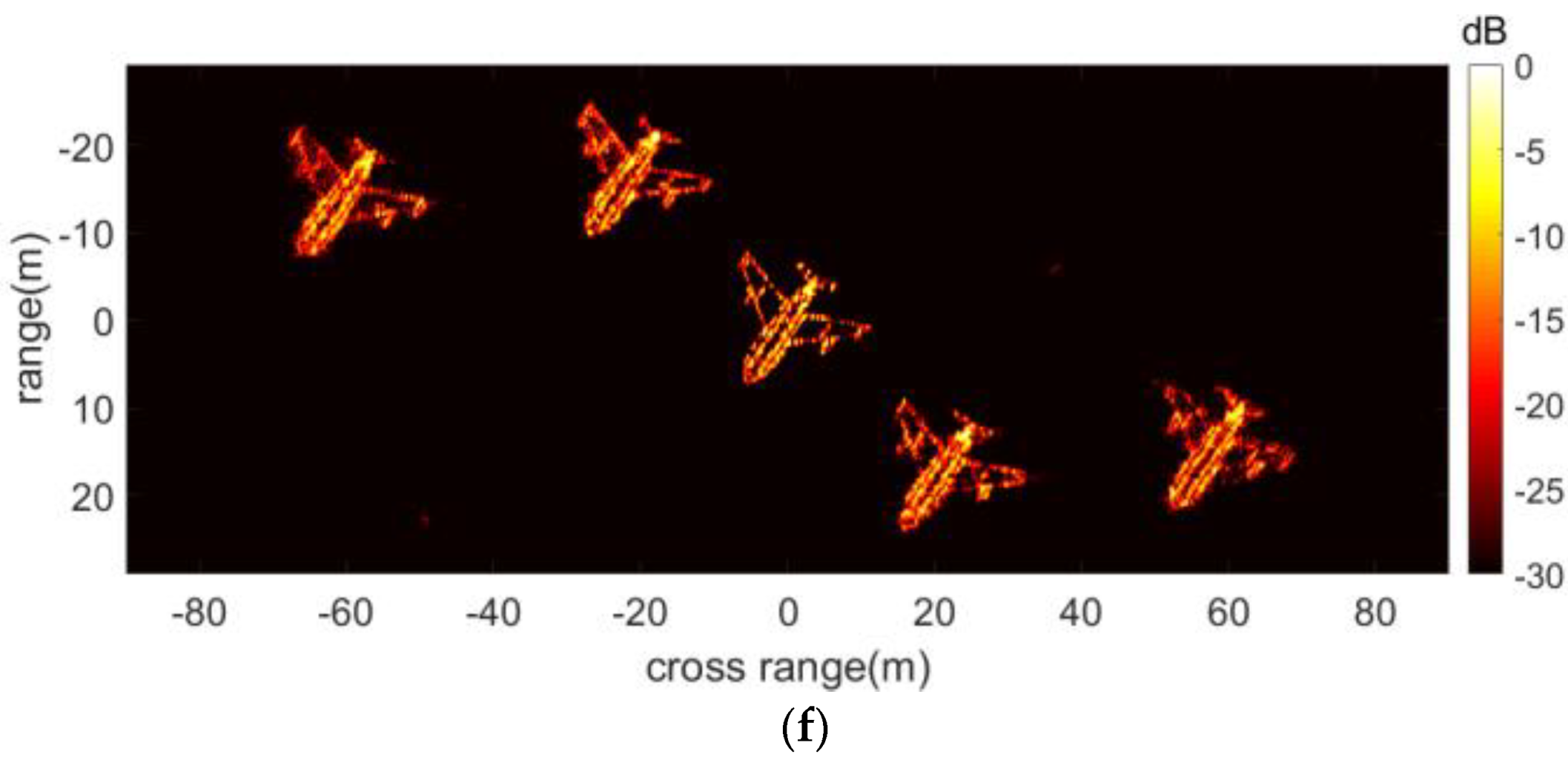
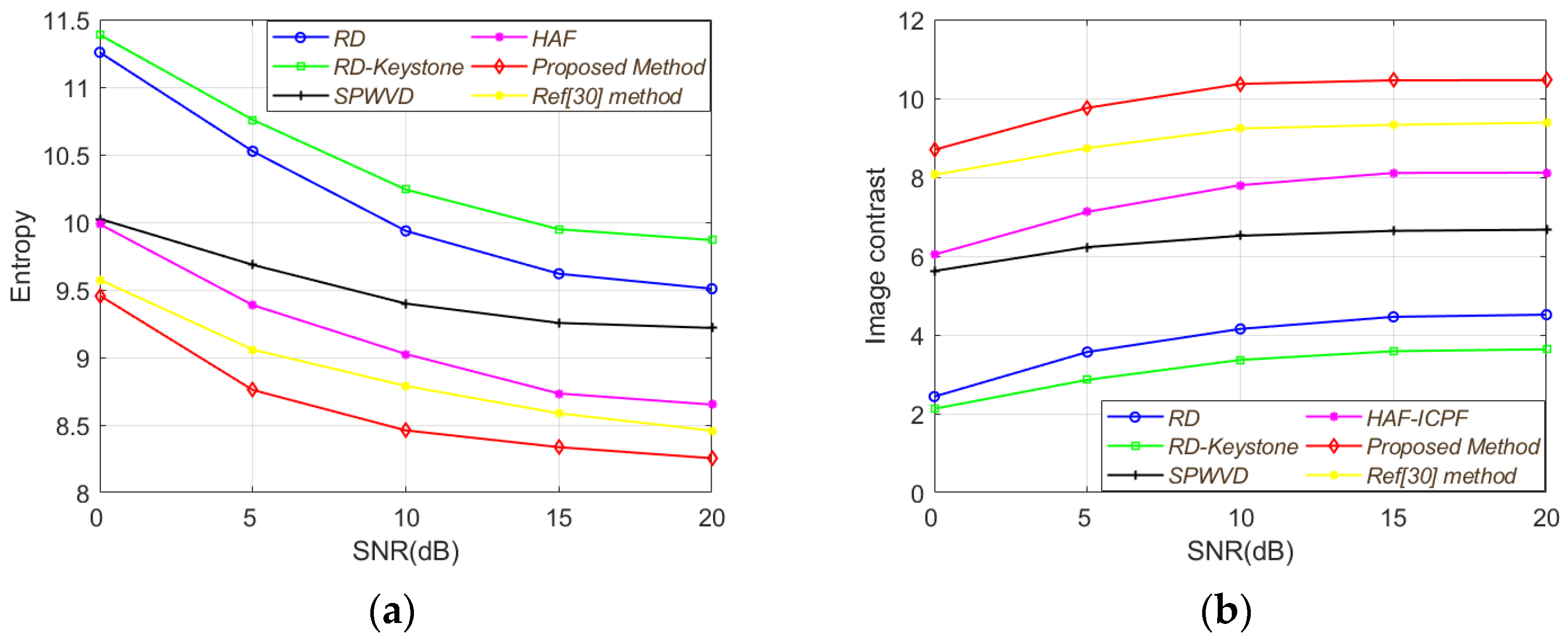
| Frequency | 9.6 GHz |
| Bandwidth | 2 GHz |
| PRF | 200 Hz |
| Pulse width | 60 μs |
| Sampling rate | 13 MHz |
| Sampling number | 512 |
| Target Code | Target 1, 5 | Target 2, 3, 4 |
|---|---|---|
| Velocity/m/s | 453.78 | 471.24 |
| A = Acceleration/m/s2 | 69.81 | 74.17 |
| Jerk/ m/s3 | 43.63 | 47.99 |
| Rotation angle/◦ | 5.77 | 6.04 |
Publisher’s Note: MDPI stays neutral with regard to jurisdictional claims in published maps and institutional affiliations. |
© 2022 by the authors. Licensee MDPI, Basel, Switzerland. This article is an open access article distributed under the terms and conditions of the Creative Commons Attribution (CC BY) license (https://creativecommons.org/licenses/by/4.0/).
Share and Cite
Liu, F.; Huang, D.; Guo, X.; Feng, C. Unambiguous ISAR Imaging Method for Complex Maneuvering Group Targets. Remote Sens. 2022, 14, 2554. https://doi.org/10.3390/rs14112554
Liu F, Huang D, Guo X, Feng C. Unambiguous ISAR Imaging Method for Complex Maneuvering Group Targets. Remote Sensing. 2022; 14(11):2554. https://doi.org/10.3390/rs14112554
Chicago/Turabian StyleLiu, Fengkai, Darong Huang, Xinrong Guo, and Cunqian Feng. 2022. "Unambiguous ISAR Imaging Method for Complex Maneuvering Group Targets" Remote Sensing 14, no. 11: 2554. https://doi.org/10.3390/rs14112554
APA StyleLiu, F., Huang, D., Guo, X., & Feng, C. (2022). Unambiguous ISAR Imaging Method for Complex Maneuvering Group Targets. Remote Sensing, 14(11), 2554. https://doi.org/10.3390/rs14112554





